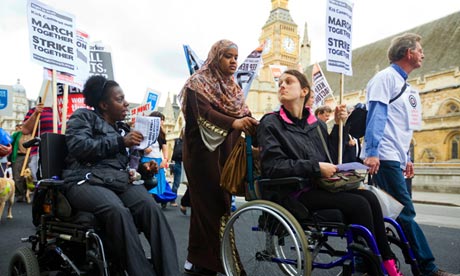Disabled people are facing life-changing losses of benefit. Why is the government unable to assess what their impact will be, asks Claudia Wood

A protest by disabled people against cuts to their benefits, Westminster, London. Photograph: Martin Argles for the Guardian
This government has undertaken the most ambitious reform of the welfare state for more than 60 years. It has set out to reduce the benefits bill by £18bn a year by 2015, through top-slicing every benefit and tax credit. For groups relying on multiple benefits – such as disabled people – this means being exposed to several cuts simultaneously.
The government has a duty to assess the impact of these policies, and has produced dozens of individual "impact assessments": analyses of how much each individual cut will save, the number of people affected and by how much. Some assessments also give breakdowns by gender and disability.
Demos has been tracking the impact of austerity on a number of disabled people supported by the charity Scope. Ahead of 1 April, when many of the cuts announced in the Welfare Reform Act 2012 come into force, we modelled a series of "cumulative impact assessments" across 15 disability benefit reforms.
At one end of the cumulative impact scale, 88,000 disabled people currently claiming employment support allowance (ESA) will feel a double whammy of a 1% cap on uprating and a 12-month eligibility limit. At the other end of the scale, at least 1,000 disabled people (possibly up to 5,000) will face six separate cuts to their benefits income. By the time the next round of cuts are due in four years, they will be £23,300 worse off per person.
In between these two groups are about 120,000 disabled people facing a triple cut, and 99,000 a quadruple cut. These combinations represent at the very least a loss of £6,309 per person by 2017. The worst loss of £23,461 per person by 2017 will be experienced by those unfortunate enough to lose their eligibility for disability living allowance and ESA, and who are reliant on other benefits that will only increase by 1% because of the rating cap or by the consumer prices index (CPI) instead of inflation.
Losses on this scale are life-changing. And yet they are underestimated, as they exclude many reforms we felt unable to model, such as changes to child benefit and tax credits and to housing benefit for disabled people renting in the private sector, due to a lack of publicly available data.
When disability groups asked the government to carry out cumulative assessments, they were told the analysis was too complex. True, not every change can be predicted and modelled, but our attempts suggest meaningful results can still be achieved with a little effort.
The Department for Work and Pensions could confirm that the impact of welfare reform is far from evenly or fairly spread. But this would add fuel to the fire for those who are already calling for a rethink on welfare reform: perhaps cumulative assessments aren't too complex, but too controversial.
Guardian